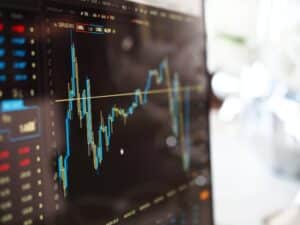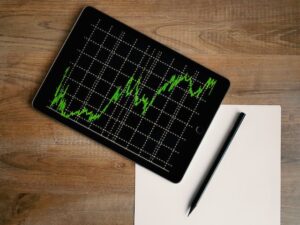Top 13 Best books for Algorithmic Trading – Beginners & Advanced Traders

Machine Learning for Algorithmic Trading: Predictive models to extract signals from the market and alternative data for systematic trading strategies with Python by Stefan Jansen (Packt Publishing)
Machine Learning for Algorithmic Trading: Predictive models to extract signals from the market and alternative data for systematic trading strategies with Python by Stefan Jansen is one of the best books for algorithmic trading. It provides a comprehensive overview of algorithmic trading, trading strategies, and algorithmic trading systems. The book covers quantitative trading, risk management, and financial markets.
One of the key takeaways from the book is that a successful algorithmic trading strategy requires a deep understanding of the financial industry. This includes knowledge of hedge funds, retail traders, and portfolio management. The book also emphasizes the importance of developing your algorithmic trading system and trading strategy.
The author explores the use of financial machine learning in algorithmic trading strategies. He discusses the advances in financial machine learning and how they can be used to develop profitable algorithmic trading strategies. The book contains actual trading strategies that can be used as a starting point for developing your own algorithmic and quantitative trading ideas.
The book also covers advanced trading strategies and automated trading strategies. It provides a thorough understanding of trading systems and algorithmic trading systems. The author emphasizes the importance of risk management in algorithmic trading and provides practical examples of how to manage risk.
Overall, Machine Learning for Algorithmic Trading is a must-read for anyone interested in algorithmic trading. Whether you are a beginner or an experienced trader, this book provides valuable insights into the world of algorithmic trading and how to develop successful trading strategies.

Why Algo Trading Is Important Even For Retail Traders?
Algorithmic trading, also known as quantitative trading, has become increasingly important in the financial markets in recent years. While it was once only accessible to large financial institutions and hedge funds, algorithmic trading is now accessible to retail traders as well. Many retail traders are now using algorithmic trading strategies to gain an edge in the markets.
One of the main advantages of algorithmic trading is its ability to manage risk. By using risk management strategies and time-weighted average price (TWAP) algorithms, traders can ensure that their trades are executed efficiently and at the best possible price. Direct market access (DMA) also allows traders to execute trades quickly and efficiently, which is especially important in fast-moving markets.
Retail traders can learn algorithmic trading by reading algorithmic trading books and studying successful trading systems. There are many popular algorithmic trading books available that cover topics such as data mining, momentum strategies, and winning strategies.
One of the leading experts in the field of algorithmic trading is Marcos Lopez de Prado. His research has shown that many commonly used trading algorithms are flawed and can lead to poor performance. By understanding the limitations of these algorithms, traders can develop more effective trading strategies.
For retail traders, developing their trading systems can be a powerful way to gain an edge in the markets. By combining their knowledge of the markets with algorithmic trading techniques, traders can create custom trading algorithms that are tailored to their specific needs.
Overall, algorithmic trading is an important tool for all traders, including retail traders. By using algorithmic trading strategies, traders can manage risk, execute trades efficiently, and gain an edge in the markets. With the help of the best algorithmic trading books and expert advice from experienced algorithmic traders, anyone can learn algorithmic trading and take advantage of this powerful tool.

Quantitative Trading: How to Build Your Own Algorithmic Trading Business by Ernest Chan
Quantitative Trading: How to Build Your Own Algorithmic Trading Business by Ernest Chan is a practical guide for traders who want to build their own algorithmic trading business. The book covers topics such as data-driven finance, execution algorithms, and winning strategies.
The book provides a step-by-step guide to building an algorithmic trading business. It covers the trader’s journey from developing their research to life to trade. The author emphasizes the importance of having a deeper understanding of portfolio construction and extensive research before deploying computer algorithms.
Quantitative Trading also covers technical indicators and technical analysis. The author explains how to use technical analysis in conjunction with computer algorithms to develop winning strategies. He also covers topics such as money management and transaction costs, which are critical for successful trading.
One of the key takeaways from the book is the importance of mastering data-driven finance. The author explains how to use the scientific method to develop and test trading strategies. He also covers topics such as Monte Carlo simulation and volume-weighted average price (VWAP), which are important for traders looking to trade in actual markets.
The book also covers high-frequency trading and market microstructure. The author provides a practitioner’s guide to developing automated strategies that can be used in the crypto market and other markets.
Overall, Quantitative Trading is an excellent resource for anyone looking to build their own algorithmic trading business. The book provides a practical guide for traders who want to deploy computer algorithms in actual markets. It is a must-read for anyone with a computer science degree who wants to become an algorithmic trader.

Machine Learning for Finance – Jannes Klaas
Machine Learning for Finance by Jannes Klaas is an excellent resource for anyone looking to understand the applications of machine learning in finance. The book covers a range of topics, from the basics of machine learning to advanced techniques for financial modeling.
One of the key takeaways from the book is the importance of data in machine learning for finance. The author emphasizes the need for high-quality data that is both accurate and reliable. He also covers topics such as data preprocessing and feature selection, which is critical for building effective machine learning models.
The book covers a range of machine-learning techniques that are commonly used in finance, including regression analysis, classification, clustering, and time-series analysis. The author provides practical examples of how these techniques can be applied to financial data, such as stock prices and economic indicators.
Another important topic covered in the book is the use of machine learning for portfolio management. The author explains how machine learning can be used to build predictive models that can be used to optimize portfolio construction and risk management.
The book also covers topics such as deep learning, reinforcement learning, and natural language processing, which have all become increasingly important in finance in recent years. The author provides practical examples of how these techniques can be used to improve financial modeling and decision-making.
Overall, Machine Learning for Finance is a valuable resource for anyone looking to understand the applications of machine learning in finance. The book provides a comprehensive overview of the field and includes practical examples and case studies that demonstrate the potential of machine learning for financial modeling and decision-making.

Python for Algorithmic Trading – Yves Hilpisch
Python for Algorithmic Trading by Yves Hilpisch is an excellent resource for traders who want to use Python to build their algorithmic trading systems. The book covers a range of topics, from the basics of Python programming to advanced techniques for financial modeling.
One of the key takeaways from the book is the importance of using Python libraries for financial modeling. The author covers a range of libraries that are commonly used in finance, including NumPy, pandas, and matplotlib. He also covers topics such as data preprocessing, feature selection, and time-series analysis, which are critical for building effective trading models.
The book covers a range of algorithmic trading strategies, including mean-reversion, trend-following, and statistical arbitrage. The author provides practical examples of how these strategies can be implemented using Python.
Another important topic covered in the book is the use of machine learning for algorithmic trading. The author explains how machine learning can be used to build predictive models that can be used to optimize trading strategies and risk management.
The book also covers topics such as backtesting, optimization, and performance evaluation, which are critical for building and testing effective trading strategies. The author provides practical examples of how to use Python to backtest and optimize trading strategies.

Advances in Financial Machine Learning by Marcos Lopez de Prado (Wiley)
Advances in Financial Machine Learning by Marcos Lopez de Prado provides a comprehensive guide to the application of machine learning in finance. The book covers a range of topics, from the basics of machine learning to advanced techniques for financial modeling.
One of the key takeaways from the book is the need for a scientific approach to financial modeling. The author emphasizes the importance of rigorous testing and validation of models, as well as the use of statistical methods to ensure that models are reliable and accurate.
The book covers a range of machine-learning techniques that are commonly used in finance, including regression analysis, classification, clustering, and time-series analysis. The author provides practical examples of how these techniques can be applied to financial data, such as stock prices and economic indicators.
Another important topic covered in the book is the use of machine learning for portfolio management. The author explains how machine learning can be used to build predictive models that can be used to optimize portfolio construction and risk management.
The book also covers topics such as deep learning, reinforcement learning, and natural language processing, which have all become increasingly important in finance in recent years. The author provides practical examples of how these techniques can be used to improve financial modeling and decision-making.
Overall, Advances in Financial Machine Learning is an excellent resource for anyone looking to understand the applications of machine learning in finance. The book provides a comprehensive overview of the field and includes practical examples and case studies that demonstrate the potential of machine learning for financial modeling and decision-making.

Algorithmic Trading Methods: Applications Using Advanced Statistics, Optimization, and Machine Learning Techniques by Robert Kissell (Elsevier)
Algorithmic Trading Methods by Robert Kissell is a comprehensive guide to algorithmic trading using advanced statistics, optimization, and machine learning techniques. The book covers topics such as backtesting, optimization, and risk management, and provides practical examples of how these techniques can be applied in algorithmic trading. The author emphasizes the importance of developing a deep understanding of the markets and the underlying fundamentals that drive them and provides practical examples of how to develop effective trading strategies. Overall, Algorithmic Trading Methods are a valuable resource for anyone looking to understand the applications of advanced statistics, optimization, and machine learning in algorithmic trading.
Algorithmic Trading: A Practitioner’s Guide – Jeffrey Bacidore
Algorithmic Trading: A Practitioner’s Guide by Jeffrey Bacidore is a practical guide to algorithmic trading for practitioners. The book covers topics such as market microstructure, order types, and execution algorithms, and provides practical examples of how these concepts can be applied in algorithmic trading. The author emphasizes the importance of having a deep understanding of the markets and the underlying fundamentals that drive them and provides practical examples of how to develop effective trading strategies. Overall, Algorithmic Trading: A Practitioner’s Guide is a valuable resource for traders and practitioners looking to understand the practical applications of algorithmic trading in the financial markets.

The Man Who Solved the Market. How Jim Simons Launched the Quant Revolution by Gregory Zuckerman (Penguin Random House)
The Man Who Solved the Market by Gregory Zuckerman is a biography of Jim Simons, the founder of Renaissance Technologies and a pioneer in quantitative finance. The book covers Simons’ early years as a mathematician and codebreaker, his pioneering work in hedge fund management, and his role in launching the quant revolution in finance. The author provides insights into Simons’ unique approach to investing and explores how his use of mathematical models and algorithms enabled him to achieve remarkable success in the financial markets. Overall, The Man Who Solved the Market is an engaging and informative book that provides a fascinating look at one of the most successful investors of our time.
Systematic Trading – Robert Carver
Systematic Trading by Robert Carver is a comprehensive guide to developing and implementing systematic trading strategies. The book covers topics such as backtesting, optimization, and risk management, and provides practical examples of how these techniques can be applied in systematic trading. The author emphasizes the importance of having a deep understanding of the markets and the underlying fundamentals that drive them and provides practical examples of how to develop effective trading strategies. Overall, Systematic Trading is a valuable resource for traders looking to understand the practical applications of systematic trading in the financial markets.

Building Winning Algorithmic Trading Systems by Kevin J. Davey (Wiley)
Building Winning Algorithmic Trading Systems by Kevin J. Davey is a practical guide to developing and implementing algorithmic trading strategies. The book covers topics such as backtesting, optimization, and risk management, and provides practical examples of how these techniques can be applied in algorithmic trading. The author emphasizes the importance of having a deep understanding of the markets and the underlying fundamentals that drive them and provides practical examples of how to develop effective trading strategies. Overall, Building Winning Algorithmic Trading Systems is a valuable resource for traders looking to understand the practical applications of algorithmic trading in the financial markets.
What Are The Essential Algorithmic Trading Books?
Many essential algorithmic trading books can provide valuable insights into the world of quantitative finance. Some of the most highly recommended books include “Algorithmic Trading: Winning Strategies and Their Rationale” by Ernie Chan, “Advances in Financial Machine Learning” by Marcos Lopez de Prado, and “Quantitative Trading: How to Build Your Own Algorithmic Trading Business” by Ernest Chan. Other notable books include “Building Winning Algorithmic Trading Systems” by Kevin J. Davey and “Systematic Trading” by Robert Carver. These books provide practical guidance and insights into the development and implementation of algorithmic trading strategies and are highly recommended for traders and investors looking to succeed in today’s financial markets.

Trading and Exchanges: Market Microstructures for Practitioners by Larry Harris
“Trading and Exchanges” by Larry Harris is a comprehensive guide for practitioners seeking to understand market microstructures. The book covers a range of topics, including the roles of traders, brokers, and exchanges, market design, order types, and the impact of technology on trading. Harris offers insights into the complex dynamics of trading and provides practical advice for navigating the rapidly evolving financial markets. This book is a valuable resource for anyone involved in trading or interested in the inner workings of financial markets.
A Guide to Creating a Successful Algorithmic Trading Strategy by Perry J. Kaufman (Wiley)
Perry J. Kaufman’s “A Guide to Creating a Successful Algorithmic Trading Strategy” offers practical advice on developing and implementing effective trading strategies using algorithms. The book covers topics such as data mining, risk management, and optimization techniques. Kaufman’s insights into the algorithmic trading process make this book a valuable resource for both novice and experienced traders.

Python for Finance: Mastering Data-Driven Finance by Dr. Yves Hilpisch (O’Reilly)
“Python for Finance” by Dr. Yves Hilpisch is a comprehensive guide to using Python for data-driven finance. The book covers topics such as data analysis, financial modeling, and algorithmic trading using Python. Hilpisch’s practical approach to using Python makes this book a valuable resource for anyone interested in finance or data analysis.
Learn Algorithmic Trading by Sebastien Donadio and Sourav Ghosh (Packt Publishing)
“Learn Algorithmic Trading” by Sebastien Donadio and Sourav Ghosh is a practical guide to developing algorithmic trading strategies. The book covers topics such as backtesting, optimization, and risk management. With clear examples and step-by-step instructions, this book is a valuable resource for anyone interested in algorithmic trading.
Want to explore more about books? Visit



